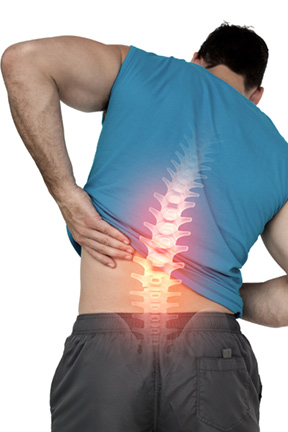…adapted from the technology behind pacemakers, spinal cord stimulation is reducing and even eliminating pain.
By Michael Ingraham, MD, Sports Medicine & Orthopaedic Center
 In pain medicine, the most common complaint we hear in an average day – and we hear it every day – is back pain. It’s not surprising, given that more than 80 percent of the population will experience back pain at least once during their lives. Most recover within a few months. Unfortunately, for those who do not, back pain can become a chronic condition that renders even the simplest daily task insurmountable, causing tremendous disruption in their lives and their families’ lives.
In pain medicine, the most common complaint we hear in an average day – and we hear it every day – is back pain. It’s not surprising, given that more than 80 percent of the population will experience back pain at least once during their lives. Most recover within a few months. Unfortunately, for those who do not, back pain can become a chronic condition that renders even the simplest daily task insurmountable, causing tremendous disruption in their lives and their families’ lives.
In appropriate cases, neuromodulation – or spinal cord stimulation – has been shown to provide significant relief from chronic back and leg pain in as many as 85 percent of patients.
The typical candidate is a patient who presents with a history of long-standing back and leg pain: a classic sciatica presentation. The patient has failed conservative management, may have undergone surgery(ies), but the pain has not resolved with traditional treatment, including opioid medication.
After assessing the patient’s receptiveness to the concept of neuromodulation, we do a five-day nonsurgical trial to determine if the technique will be effective. This involves numbing the patient’s skin, and through two small needles, we pass a catheter into the epidural space. We then stimulate the spinal cord, blocking some of the pain signals coming from the brain. Thus, rather than pain, the patient feels a slight tingling – or in the best case scenario, nothing at all.
The trial procedure takes less than an hour, and the patient can go home after the leads are placed. If the trial is successful, and the patient enjoys relief from pain, we can then repeat the process, this time implanting a small battery under the skin, akin to that used in pacemakers, to power the stimulator.
The different models available allow us to customize both the procedure and the kind of device we implant. Some patients don’t like to charge their devices, and thus prefer a permanent battery, which must be replaced after three to five years. Some of the more technologically savvy like the ability to change the settings throughout the day, increasing or decreasing stimulation in response to their symptoms. As the technology has become more sophisticated, we’ve developed new and innovative ways of using these devices, and many patients who had all but given up hope are experiencing as great as a 70 percent reduction in their pain.
In two recent randomized controlled trials of patients with predominant leg pain, spinal cord stimulation was found to be more effective than reoperation and conventional medical management. It’s also been demonstrated to be more effective in treating persistent sciatic pain after spine surgery, often eliminating the need for reoperation. Additionally, in a conventional medical management study, more subjects randomized to spinal cord stimulation had a significant reduction in leg pain.
Today, rather than waiting until all other treatments have failed, neuromodulation is beginning to be introduced earlier into the algorithm. We’re starting to offer it earlier and earlier, as new research proves it to be an ever more viable option.
 Michael Ingraham, MD is a fellowship trained pain medicine physician, who will join Sports Medicine & Orthopaedic Center in August 2016. He completed his internship at Harvard University/Beth Israel Deaconess Medical Center, and his residency in physical medicine and rehabilitation at Georgetown University/National Rehabilitation Hospital. He did his fellowship in pain medicine at the University of Virginia School of Medicine. smoc-pt.com
Michael Ingraham, MD is a fellowship trained pain medicine physician, who will join Sports Medicine & Orthopaedic Center in August 2016. He completed his internship at Harvard University/Beth Israel Deaconess Medical Center, and his residency in physical medicine and rehabilitation at Georgetown University/National Rehabilitation Hospital. He did his fellowship in pain medicine at the University of Virginia School of Medicine. smoc-pt.com

